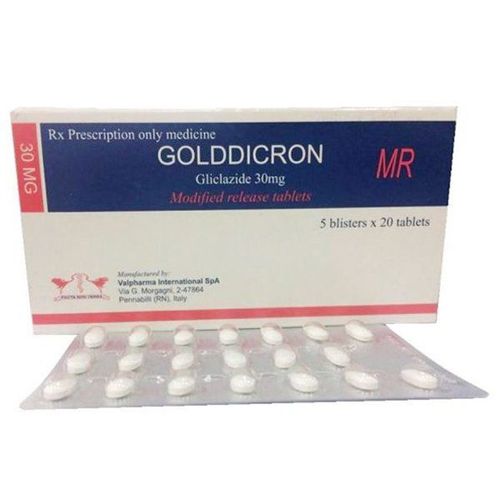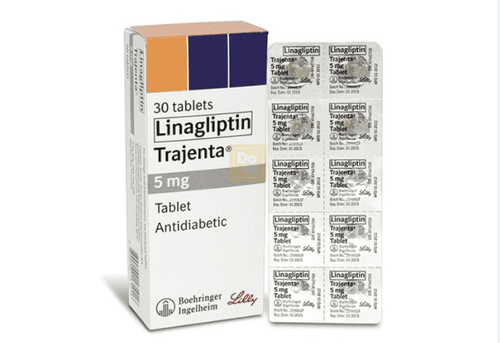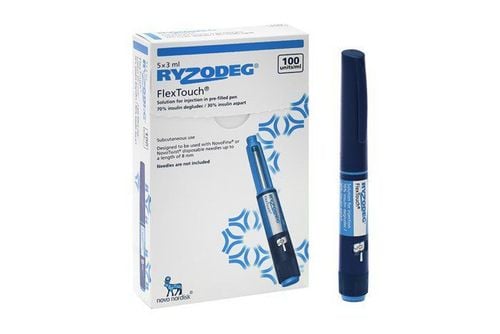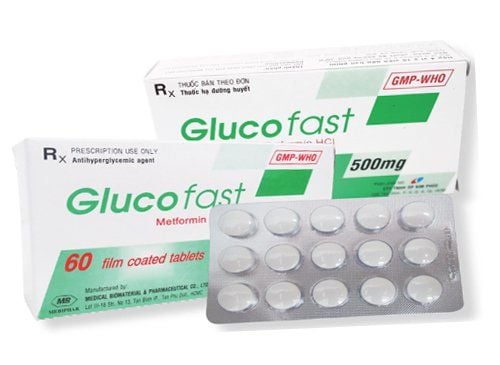This is an automatically translated article.
Diabetes is an extremely common disease today, so the demand for drugs in combination with groups of drugs to control blood sugar is increasing. One such drug is Perglim M-2 with a combination of Metformin and Glimepiride. So what is Perglim M-2?
1. What is Perglim M-2?
Perglim M-2 is a drug of Inventia Healthcare Pvt. Ltd. (India), the main active ingredients include Glimepiride and Metformin Hydrochloride. Therefore, Perglim M-2 is an adjunct to blood sugar control and is indicated in the treatment of patients with non-insulin dependent diabetes mellitus (type 2 diabetes mellitus) over 18 years of age.
Perglim M-2 diabetes drug is in tablet form, each containing 2mg Glimepiride and 500mg Metformin Hydrochloride.
2. What does Perglim M-2 do?
2.1. Indications Perglim M-2 diabetes drug is indicated for use in the following cases:
People over 18 years of age with non-insulin dependent diabetes mellitus (type 2), when lifestyle measures are not controlled blood sugar (including dietary changes, increased exercise, and weight loss); Replace stable blood sugar control with Glimepiride (1-2 mg dose) and Metformin (500mg delayed release dose). 2.2. Pharmacodynamics Active ingredient Glimepiride is essentially an orally administered sulfonamide, belonging to the sulfonylurea group with hypoglycaemic effects. The main effect of this active substance is to stimulate the pancreatic Langerhans beta cells to release insulin. Besides, Glimepiride also has some extrapancreatic effects such as improving the sensitivity of peripheral tissues to insulin and reducing insulin absorption in the liver. Glimepiride stimulates a rapid increase in the number of glucose transporters across the membranes of muscle and fat cells, thereby stimulating the uptake of glucose into these tissues. When used in combination with Metformin, Glimepiride has a synergistic effect. The other active ingredient in Perglim M-2 is Metformin, which belongs to the biguanide group and has a different hypoglycemic mechanism than the sulfonylurea group when it does not stimulate the pancreas to release insulin. In diabetic patients, Metformin helps blood sugar not to rise, and has the advantage of not causing hypoglycaemic events (except in cases of fasting or in combination with other antidiabetic drugs). Therefore, in essence, Metformin must be considered an appropriate anti-hyperglycemic agent. The mechanism of glycemic control (both fasting and postprandial) of Metformin is to stimulate cells to increase glucose utilization, improve insulin binding to receptors, inhibit hepatic glucose synthesis, and decrease glucose absorption in intestine.
Metformin monotherapy has a good effect on patients who do not respond, partially respond or no longer respond to sulfonylurea. In cases of unresponsive to Sulfonylurea when using Metformin monotherapy and still cannot control blood sugar as required, Metformin can be combined with a Sulfonylurea (such as Perglim M-2), thereby bringing about a synergistic effect. , improves glucose tolerance through different but complementary mechanisms.
2.3. Glimepiride Pharmacokinetics:
The bioavailability of this active substance is very high. Although food does not significantly affect the absorption of Glimepiride, the overall rate of absorption appears to be slower. Maximum plasma concentrations are reached approximately 2 hours and 30 minutes after dosing: Glimepiride has a very low volume of distribution, strong plasma protein binding (above 99%) and low clearance (approximately 48ml/min). . The plasma half-life of Glimepiride is 5-8 hours and longer but at high doses; Glimepiride is eliminated in urine and faeces after hepatic metabolism; According to some animal studies, Glimepiride is excreted in human milk, crosses the placental barrier, but hardly crosses the blood-brain barrier. Metformin:
Metformin after oral administration has the ability to be absorbed slowly and incompletely. The absolute bioavailability of 500 mg of Metformin in the fasted state is only about 50-60%. Food is a factor that can reduce levels and slow down the absorption of Metformin; Metformin's plasma protein binding is negligible. After entering the body it is rapidly distributed into tissues and fluids, even in red blood cells; Metformin is not metabolised in the liver and is not excreted in the bile. The major route of excretion of Metformin is via the renal tubules. The plasma half-life ranges from 1.5 to 4.5 hours; The risk of Metformin accumulation is higher in cases of impaired renal function. Therefore, caution should be exercised in patients with renal impairment and the elderly.
3. Instructions on how to use Perglim M-2
3.1. How to take Perglim M-2 diabetes drug is taken orally. When taking, the tablet should be swallowed whole with water, do not crush or chew. Initially, patients may take 1 tablet daily with the aim of reducing fasting blood sugar and supporting normalization of HbA1C values at the minimum effective dose.
3.2. Dosage The dosage of Perglim M-2 drug is 1 tablet / time / day or as prescribed by a specialist.
Dosage of Perglim M-2 drug depends on each individual patient because the tolerability and effectiveness of the drug is different for each person. Do not exceed the maximum recommended dose of 2000mg Metformin and 8mg Glimepiride per day.
4. Perglim M-2 . side effects
Hypoglycemia : This effect may be related to the active ingredient Glimepiride; Temporary visual disturbances due to changes in blood glucose, especially during the initial period of use of Perglim M-2; Digestive disorders such as nausea, vomiting, pain or flatulence in the epigastrium, abdominal pain and diarrhea; Increased liver enzymes, liver failure, hepatitis, cholestatic jaundice; Hematologic disorders such as low platelet count (very rare), leukopenia, hemolytic anemia, erythrocytosis and possibly total hematopoiesis; Allergic or pseudo-allergic reactions such as itching, urticaria or rash, more severe may be accompanied by difficulty breathing, low blood pressure, shock; Allergic vasculitis, increased photosensitivity and hyponatremia.
5. Contraindications of the diabetes drug Perglim M-2
Insulin-dependent diabetes mellitus (type 1), diabetes mellitus pre-coma or coma; People who are sensitive to Metformin Hydrochloride, Glimepiride, Sulfonylurea and other sulfonamides; Renal dysfunction; Patients with type 2 diabetes with acute severe stress such as severe infection, major surgery, trauma; Before taking X-ray, use contrast material containing iodine; Patients with liver damage; Alcoholics; People who lack folic acid, vitamin B12 and iron; Diabetic patients with complications of ketoacidosis; Patients with severe cardiovascular or respiratory disease; Patients with poor physical condition such as dehydration, malnutrition...; Patients with diabetes with renal or retinal complications.
6. Some precautions when using Perglim M-2
Precautions regarding the active substance Glimepiride:
Patients at high risk of hypoglycaemia require a dose adjustment of Glimepiride or other general therapy; Manifestations of hypoglycemia are usually milder or absent in the elderly, in patients with autonomic neuropathy, being treated with beta-blockers, clonidine, reserpine, guanethidine, or other drugs. other sympathomimetic inhibition; Most cases of hypoglycemia can be controlled with immediate carbohydrate supplementation (such as sugar, juice, or sugared tea). Patients need to carry at least 20g of sugar with them at all times. Note that artificial sweeteners are not effective in treating hypoglycemia; Severe cases of hypoglycemia require close monitoring and immediate treatment; In cases of acute stress (such as trauma, surgery, severe infection) that impair blood sugar control, it is necessary to temporarily switch to insulin replacement therapy; During treatment with Glimepiride, patients must regularly check blood sugar, urinary glucose and HbA1C value; Alertness may be impaired due to hyperglycemia or hypoglycemia, especially in the early stages of initiation, discontinuation or irregular use of the drug, and this adversely affects the ability to drive and use machines. Some cautions regarding Metformin:
Lactic acidosis: Metformin can cause lactic acidosis at an extremely low rate. This risk is proportional to age and degree of kidney failure in addition to other factors such as liver failure, hypoxemia, dehydration, infection, alcoholism...; Impaired renal function: Caution should be exercised when using Perglim M-2 because of the risk of affecting renal function or the distribution of Metformin; Iodine-containing contrast agents: Metformin-containing drugs should be discontinued at least 2 days prior to the time of radiography using iodinated contrast and resumed when renal function returns to normal; In case of tissue hypoxia, treatment with Metformin should be discontinued; Surgery: Temporarily discontinue Perglim M-2 and restart it when the patient is able to eat and drink on his own and with normal renal function; Alcohol use: Physicians should warn patients about the risk of acute or chronic interactions between alcohol and Metformin; Impaired liver function: Patients with liver failure should avoid using Metformin; Hypoglycemia: This effect does not occur with Metformin monotherapy but may occur with combination therapy (eg Perglim M-2) and/or alcohol. Some other cautions of Perglim M-2:
Women in pregnancy often have contraindications to Perglim M-2 and most need to be replaced by insulin therapy; Lactation: Components of the drug Perglim M-2 are excreted in breast milk, so it should not be used by women who are breastfeeding; Elderly: Special care should be taken, blood creatinine should be checked regularly and the dose of the antidiabetic drug Perglim M-2 should be reduced in this group of patients.
7. Perglim M-2 . Drug Interactions
Cimetidine: Metformin interacts with Cimetidine, so it is necessary to reduce the dose when used simultaneously; Drugs causing hyperglycaemia such as thiazide diuretics, corticosteroids and some other drugs... can interfere with the anti-hyperglycemic effect of Metformin. Therefore, it is advisable to control blood glucose closely in such cases; Alcohol enhances the effects of Metformin, including lactate metabolism and antihyperglycemic effect; Diuretics Furosemide and Nifedipine may increase plasma Metformin concentrations; Acarbose may reduce the absorption of metformin; The risk of hypoglycaemia is higher when glimepiride is combined with insulin, oral antidiabetic agents, ACE inhibitors, allopurinol, anabolic steroids, male sex hormones, chloramphenicol, Coumarin derivatives, cyclophosphamide, disopyramide; Fenfluramine, febyramidol, fibrates, Fluoxetin, Guanethidine, Ifosfamide, MAO inhibitors, Miconazole, Pentoxifylline, Phenylbutazone, Azapropazone; Oxyphenbutazone, Probenecid, Quinolone, Salicylate, Sulfinpyrazone, Tetracycline, Tritoqualin, Trofosfamide; Hyperglycemia may occur when Glimepiride is used in combination with Acetazolamide, Barbiturates, Corticosteroids, Diazoxide, Diuretics, Epinephrine (adrenalin) and other sympathomimetic agents, Glucagons, Laxatives, Nicotinic Acid, Oestrogen and Progesteron, Phenothiazine, Phenytoin, Rifampicin, thyroid hormone. Perglim M-2 is an adjunct to glycemic control and is indicated in the treatment of patients with non-insulin dependent diabetes mellitus (type 2 diabetes mellitus) over 18 years of age. To ensure effective treatment and avoid side effects, patients need to take drugs according to prescription or under the direction of a doctor or pharmacist.
Follow Vinmec International General Hospital website to get more health, nutrition and beauty information to protect the health of yourself and your loved ones in your family.
Please dial HOTLINE for more information or register for an appointment HERE. Download MyVinmec app to make appointments faster and to manage your bookings easily.













